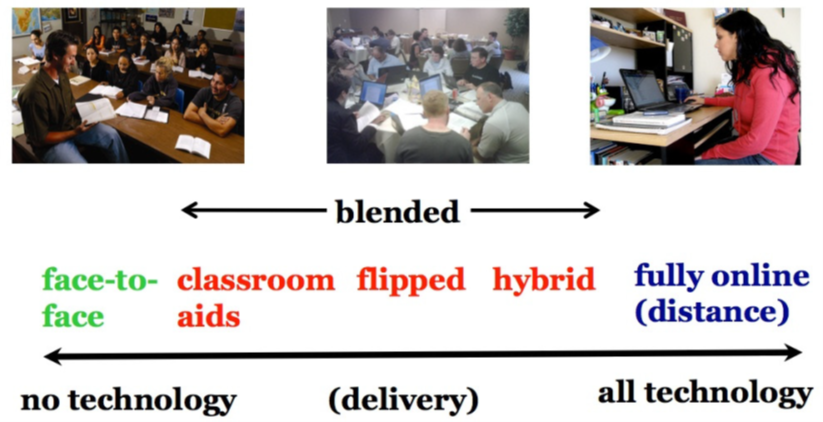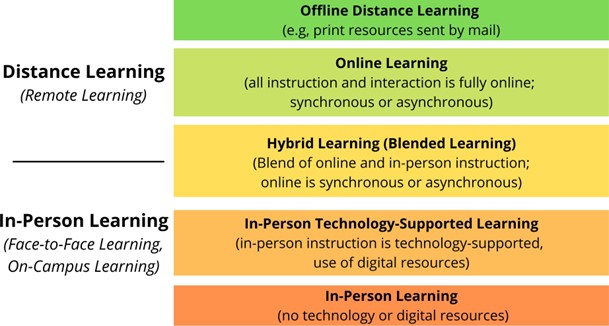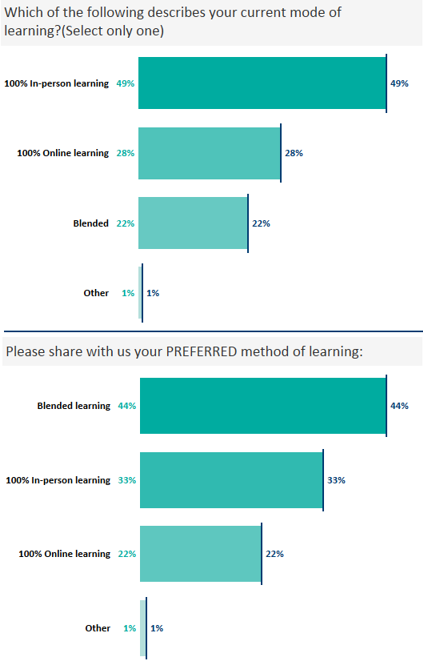Unit 2 What’s Online: Defining and Designing Digital Learning Spaces
1. Defining Delivery Modes and elearning at BCIT
Defining Delivery Modes
Let’s start by clarifying the terminology and clarify what we mean when we are talking about online learning. We take our definitions of delivery modes from the work done by the Canadian Digital Learning Research Association:
| ONLINE LEARNING means all instruction and interaction is fully online (synchronous or asynchronous) |
| HYBRID LEARNING means a blend of online and in-person instruction (online instruction is synchronous or asynchronous) |
| HYFLEX LEARNING means instruction is available online and in-person and students can move between online and in-person |
| IN-PERSON LEARNING means all instruction takes place in an in-person setting |
| SYNCHRONOUS LEARNING means instruction takes place in real-time and requires student presence |
| ASYNCHRONOUS LEARNING means instruction is available for students to access at a time that works best for them |
In the field of educational technology, we often talk about how we use education technologies in varying configurations, such as in this image:
 Source: BCIT Guidance for Course Delivery Decision-Making
Source: BCIT Guidance for Course Delivery Decision-Making
However, this image conflates the use of educational technology with delivery models (or modes). Imagine twenty years ago when it was possible to use no educational technology during in-person learning – that’s the fellow on the left, reading from his papers in front of his students. As we move to the middle of the continuum above, educational technologies are being to support in-person learning activities (the photo in the centre, where people are using computers to collaborate in-person). On the right, educational technologies are used to support the delivery of a fully online course (the photo on the right, where the learner is on her own interacting in the digital space with the learning environment). What is confusing is the image in the middle: even though the participants are using computers, the delivery mode remains in-person.
With the sudden switch to remote teaching during the pandemic, much work was done in the educational technology field to clarify definitions and find consensus regarding online learning. The focus of the definitions turned to defining the use of educational technologies for delivery modes. What has been clearly omitted is all of the other reasons that instructors will use educational technologies to support their teaching.
The graphic below produced by the Canadian Digital Learning Research Association nicely illustrates a new continuum focused on delivery modes, which range from fully distance-based learning (online or offline) to in-person learning.
 Source: From the Canadian Digital Learning Research Association’s 2021 report, Evolving Definitions under a Creative Commons Attribution-No Derivatives 4.0 International (CC BY-ND 4.0) License
Source: From the Canadian Digital Learning Research Association’s 2021 report, Evolving Definitions under a Creative Commons Attribution-No Derivatives 4.0 International (CC BY-ND 4.0) License
From their 2021 report, the Canadian Digital Learning Research Associate describes the modes of the learning spectrum as:
Distance learning is defined as all learning that takes place at a distance. Online learning (where the learning experience is delivered via the Internet either synchronously or asynchronously) is the predominant mode of distance learning; however, distance learning also includes offline distance learning (where the learning experience is fully remote but does not use Internet technology, such as a course being delivered in print format via mail).”
In-person learning is defined as learning that takes place entirely within a physical classroom with one’s peers and instructor physically present. In-person learning may use technology within the classroom, or technology available on-campus, to facilitate learning and students may be expected to use technology (e.g., Learning Management System (LMS), digital textbooks, laptop computer) to complete course assignments. All instruction takes place in a physical classroom context.
The dividing line between distance learning and in-person learning is placed at the centre of hybrid learning.
Hybrid learning is a learning experience that is designed to combine both online and in-person instruction. While some institutions have separate definitions for hybrid learning and blended learning, it appears that these terms are used interchangeably for the most part. For consistency’s sake, the Modes of Learning Spectrum uses the term hybrid learning, but considers it to be interchangeable with blended learning.
Hybrid learning presents the greatest area of ambiguity, especially as different forms of hybrid learning have emerged. The term hybrid learning is an umbrella term that captures all different types of hybrid learning such as flipped learning, hyflex learning, and online learning with an in- person intensive component. There are varying definitions for these terms and further definitional work specific to types of hybrid learning is needed.
It is important to note that some forms of hybrid learning require students to participate in both an online learning mode and an in-person learning mode whereas other forms of hybrid learning provide both options, but leave the choice of learning mode to the student. For example, hyflex learning is emerging as an option at more and more institutions across Canada, in which students enroll in a course that offers them the ability to choose their mode of delivery (in-person or online) and shift modes of delivery during the course in accordance with their individual needs and preferences. (pg 7-9)
From the Canadian Digital Learning Research Association’s 2021 report, Evolving Definitions [1] under a Creative Commons Attribution-No Derivatives 4.0 International (CC BY-ND 4.0) License
Hyflex is emerging
As mentioned above, Hyflex is an evolving and emerging approach. As of this writing, Hyflex currently means courses that are blended courses with the exception that students have the choice to participate in the synchronous portion either in-person, on campus, or online via web conferencing. Further variations also include a third option of participation, which is when the live session is recorded and students can access the live session afterwards.
HyFlex courses are meant to be student-centered course offerings that give students options. Students have the ability to choose their mode of attendance with flexibility each week and are not locked into the same format over the course of the semester. The belief is that if students have the freedom to choose which mode to participate in over their time in the course; they are able to create their own learning experience.
Hyflex delivery modes could be considered when there is a need to serve online students and face-to-face students in the same class sections, especially when there are limited resources. There are not many instances of Hyflex at BCIT at the moment, but it is has become a consideration in the planning of new on-campus learning spaces.
In summary, the University of Windsor created this very handy summary of the different modes:
Source: University of Windsor, Overview of Course Delivery Modes
About our institutional context and BCIT students
As a polytechnic vocational institution, BCIT’s mandate often makes us think that fully online learning is not popular nor suitable for our hands-on applied-focus education. However, we also happen to be one of the largest distance-education providers in the province, and that was before the introduction of online learning when courses were paper-based. With the advent of online learning capabilities, our capacity for increasing the number of course and program offerings available fully online has grown substantially. When it makes good business sense, we can and do put full programs online. However, not only has BCIT embraced online learning for fully distance-based online courses, but also individual instructors right across the institute integrate using the learning management system (the Learning Hub) in various ways to support their teaching.
And what do our students say about online learning at BCIT? They seem to be okay with it, according to the Institute’s 2022 Student Check-in Survey Final Report.
In the fall of 2022, BCIT’s Institutional Research sent out a survey to 21,625 students enrolled across all schools and programs and received 3,222 responses (15% response rate after accounting for bounce-back emails). The purpose of the annual survey is to reach out to current students (full time and part time) and learn more about their needs, challenges, and future considerations. The survey also provides an insight into the awareness, usage, and satisfaction of these students with the services available to them.

While only 22% of respondents were currently learning in a blended mode, 44% said a blended mode was their preferred mode. This feedback tells us that our students may be more ready than we think for shifting part of their courses online. With the return to campus-based in-person delivery after the pandemic, students are asking for those in-person courses to contain an online element. For students who are in a 100% online delivery mode, they would have made that choice before they registered, as programs that are 100% online and Flexible Learning courses that are fully online are communicated as such in advance. The take-away message for instructors and programs that have returned to 100% in-person teaching: our students are ready for us to introduce blended learning elements into our course delivery.
And it is because our students are asking for more blended learning elements into our course delivery that instructors should be prepared with the appropriate knowledge and skills to determine how best to integrate online learning elements into their courses, should they choose. While we often refer to facilitating online learning, we include blended learning delivery modes in that term. The intention is for all instructors to know what key elements go into a quality online learning course. In this way, instructors who decide to move to a blended delivery mode are prepared to design, develop, and deliver the online elements that best fit their course.
- http://www.cdlra-acrfl.ca/wp-content/uploads/2021/07/2021-CDLRA-definitions-report-5.pdf ↵

